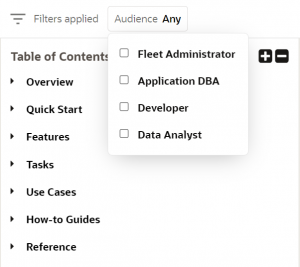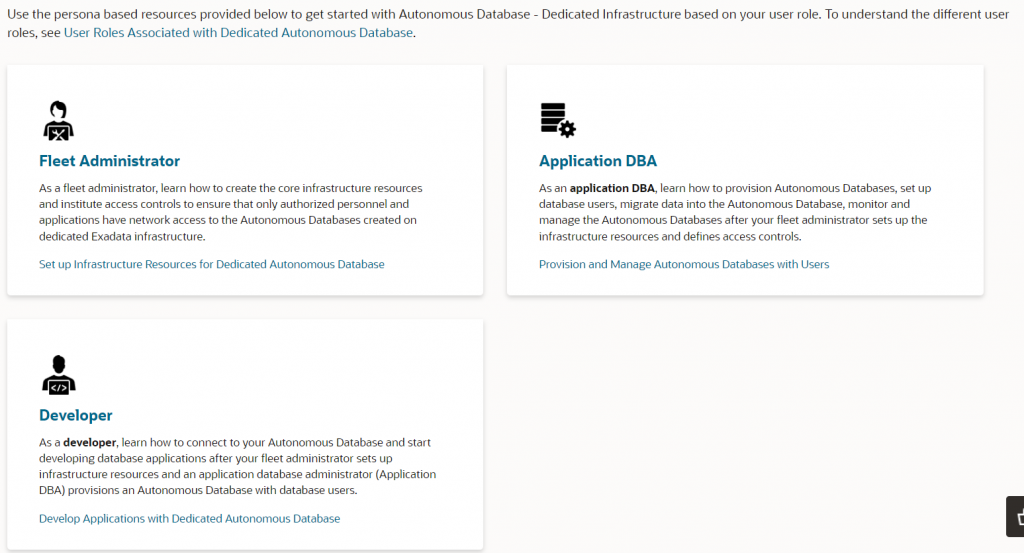1-Minute (or Less) Summary
These UA implementations made Autonomous Database documentation easier to locate, consume, and try. Though currently implemented in Autonomous Database on Dedicated Exadata Infrastructure, they will be expanded to all database documentation over time, as appropriate.
Let’s get started!
The Whole Story
UA guys at Autonomous Database on Dedicated Exadata Infrastructure have been working through adding more and more enhancements to its technical documentation.
Intuitive Classification
Autonomous Database articles are now reorganized into groups that are more intuitive to the audience!
An article is a single-page publication (with scrolling) that contains all the topics needed to cover a specific customer need. Look into Quick Start to get hold of the service quickly and try out our Live labs or get inside Features to explore a specific feature you’re interested in. If you are already using the service for some time and looking for detailed instructions on implementing something, jump straight into How-to Guides and get going! Tasks guide you in using the service for a specific job, such as migration, cloning, development, user management, and many more. Get a peek at the latest announcements and typical workflows from Overview and find many reference materials in the Reference section. Try it!

Self-Contained Articles
We now have articles that give you a holistic picture of the critical Autonomous Database features backed up with overview graphics, use cases, or lists wherever applicable.
Look into the Key Security Features for a bird’s eye view of various security features supported by Autonomous Database and how each is related. Check out the Service Maintenance article for in-depth information about Autonomous Database’s change management capabilities. Explore the Migrate and Load articles to provide a comprehensive list of migration options mapped to the applicable use cases. Along with a big picture of a service feature, you will also find helpful pointers to the related how-to guides wherever appropriate. Isn’t this valuable?
More and more features to follow this route!
Badges
Badges? Yes, badges. As our documentation covers Autonomous Database on Oracle Public Cloud and Exadata Cloud@Customer (ExaCC) platforms, we devised badges to tag the content that only applies to either platform:
- APPLIES TO: Oracle Public Cloud only
- APPLIES TO: Exadata Cloud@Customer only
Even though both platforms support a standard set of features for Autonomous Databases, there are a few exceptions where only one of these platforms supports a feature. For example, Changing the License Type on an Autonomous VM Cluster is supported only on the Exadata Cloud@Customer platform where as Using Operations Insights on Autonomous Database is only allowed on Oracle Public Cloud.
Tip: For the complete list of features supported exclusively by Oracle Public Cloud or Exadata Cloud@Customer platforms, refer to Feature Parity Between Oracle Public Cloud and Exadata Cloud@Customer Deployments.
Role Based Navigation
You may be a developer interested in the content appropriate to developing applications with Autonomous Database or a fleet administrator trying to perform some administrative tasks for your service. It has gotten easier if you’re looking for user role-specific tasks with Autonomous Database. You can now see user-role-specific tiles on the Autonomous Database landing pages in Oracle Help Center (OHC). Click the tile you’re interested in, and the content that applies to that specific user role is loaded! I hope this is useful, and try it out the next time you need it.
Tip: See User Roles Associated with Autonomous Database to understand the different user roles.

This is not an exhaustive list of enhancements implemented in 2022 but an attempt to capture what’s happening in the User Assistance area for the Autonomous Database.
Thanks to all the product managers for their continuous guidance and support in implementing these and many more!